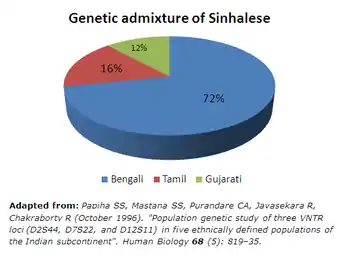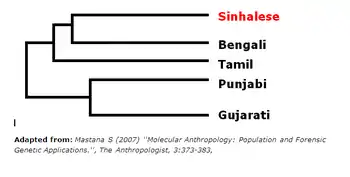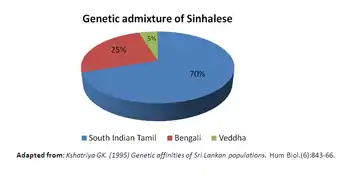Genetic studies on Sinhalese
Genetic studies on the Sinhalese is part of population genetics investigating the origins of the Sinhalese population.

All studies agree that there is a significant relationship between the Sinhalese and the Bengalis and South Indian Tamils and that there is a significant genetic relationship between Sri Lankan Tamils and Sinhalese, them being closer to each other than other South Asian populations.This is also supported by a genetic distance study, which showed low differences in genetic distance between the Sinhalese and the Bengali, Tamil, and Keralite volunteers. The Up Country Sinhalese (mountainous region) and Low Country Sinhalese have different genetic phenotypes according to observations, with the up country Sinhalese looking slightly more Caucasoid, compared to the low country Sinhalese, who’s castes are known to have origins in South India, altough no formal study has been conducted on such matters. The vast genetic diversity of the Sinhalese has intrigued anthropologists on their genetic origins. [1]
A 2017 study conducted by Fumihiko Takeuchi, Tomohiro Katsuya, Ryosuke Kimura and Norihiro Kato showed that the main ancestral population that contributed to the Sinhalese was the "South Asian" component with a significant contribution from the "South Asian and Central Asian" component and smaller contributions from the "Central Asian", "Southeast Asian", "Southeast Asian and East Asian", "East Asian" and "Japanese" components.[2]
Relationship to Bengalis

An Alu polymorphism analysis of Sinhalese from Colombo by Dr Sarabjit Mastanain in 2007 using Tamil, Bengali, Gujarati (Patel), and Punjabi as parental populations found different proportions of genetic contribution:[3]
| Statistical Method | Bengali | Tamil | North Western |
|---|---|---|---|
| Point Estimate | 57.49% | 42.5% | - |
| Maximum Likelihood Method | 88.07% | - | - |
| Using Tamil, Bengali and North West as parental population | 50-66% | 11-30% | 20-23% |
A genetic distance analysis by Dr Robet Kirk also concluded that the modern Sinhalese are most closely related to the Bengalis.[1]
This is further substantiated by a VNTR study, which found 70-82% of Sinhalese genes to originate from Bengali admixture:[4]
| Parental population | Bengali | Tamil | Gujarati | Punjabi |
|---|---|---|---|---|
| Using Tamil and Bengali as parental population | 70.03% | 29.97% | - | |
| Using Tamil, Bengali and Gujarati as parental population | 71.82% | 16.38% | 11.82% | |
| Using Bengali, Gujarati and Punjabi as parental population | 82.09% | - | 15.39% | 2.52% |
D1S80 allele frequency (A popular allele for genetic fingerprinting) is also similar between the Sinhalese and Bengalis, suggesting the two groups are closely related.[5] The Sinhalese also have similar frequencies of the allele MTHFR 677T (13%) to West Bengalis (17%).[6][7]
A test for Y-chromosome DNA haplogroups conducted by Dr Toomas Kivisild on Sinhalese of Sri Lanka has shown that 23% of the subjects were R1a1a (R-SRY1532) positive.[8] Also in the same test 24.1% of the subjects were R2 positive as subclades of Haplogroup P (92R7).[8] Haplogroup R2 is also found in a considerable percentage among Bengali of India. Sample size used was 87 subjects.


A study in 2007 found similar frequencies of the allele HLA-A*02 in sinhalese (7.4%) and North Indian subjects (6.7%). HLA-A*02 is a rare allele which has a relatively high frequency in North Indian populations and is considered to be a novel allele among the North Indian population. This suggests possible North Indian origin of the Sinhalese.[9]
Relationship to Tamils

Another study by GK Kshatriya conducted in 1995 assessing the 'Genetic affinities of Sri Lankan Populations' found a large genetic contribution from the Tamils of South India, as well as from the Bengali and Vedda populations. The study was carried out using Sinhalese from regions where Sinhala Tamil interactions were higher and older methods compared to other modern and accurate studies.[10]
| Parental population | Tamil | Bengali | Vedda |
|---|---|---|---|
| Using Tamil, Bengali and Vedda as parental population | 69.86% | 25.41% | 4.73% |
Relationship to other ethnic groups in Sri Lanka
A study looking at genetic variation of the FUT2 gene in the Sinhalese and Sri Lankan Tamil population, found similar genetic backgrounds for both ethnic groups, with little genetic flow from other neighbouring Asian population groups.[11] Studies have also found no significant difference with regards to blood group, blood genetic markers and single-nucleotide polymorphism between the Sinhalese and other ethnic groups in Sri Lanka.[12][13][14] Another study has also found "no significant genetic variation among the major ethnic groups in Sri Lanka".[15] This is further supported by a study which found very similar frequencies of alleles MTHFR 677T, F2 20210A & F5 1691A in South Indian Tamil, Sinhalese, Sri Lankan Tamil and Moor populations.[7]
A genetic study carried out in 2015 by Lian dang et. on origin of Malay people and other populations of Sri Lanka involving 200 Sinhalese people, 103 Tamil people of Sri Lankan origin, 200 Tamil people of Indian origin and 35 Burgher people calculated the averaged genetic makeup across individuals of each population,[16] which show substantially higher amount of Central Asian ancestry and low South Asian ancestry among Sinhalese compared to both Tamil groups.
Relationship to East and Southeast Asians
Genetic studies show that the Sinhalese have received some genetic flow from neighboring populations in East Asia and Southeast Asia, such as from the ethnically diverse and disparate Tibeto-Burman peoples and Austro-Asiatic peoples,[17] which is due to their close genetic links to Northeast India.[18][19][20] A 1985 study conducted by Roychoudhury AK and Nei M, indicated the values of genetic distance showed that the Sinhalese people were slightly closer to Mongoloid populations due to gene exchange in the past.[21][22] In regards to comparisons of root and canal morphology of Sri Lankan mandibular molars, it showed that they were further away from Mongoloid populations.[23] Among haplogroups found in East Asian populations, a lower frequency of East Asian mtDNA haplogroup, G has been found among the populations of Sri Lanka alongside haplogroup D in conjunction with the main mtDNA haplogroup of Sri Lanka's ethnic groups, haplogroup M.[24] In regards to Y-DNA, Haplogroup C-M130 is found at low to moderate frequencies in Sri Lanka.[25]
Genetic markers of immunoglobulin among the Sinhalese show high frequencies of afb1b3 which has its origins in the Yunnan and Guangxi provinces of southern China.[26] It is also found at high frequencies among Odias, certain Nepali and Northeast Indian, southern Han Chinese, Southeast Asian and certain Austronesian populations of the Pacific Islands.[26] At a lower frequency, ab3st is also found among the Sinhalese and is generally found at higher frequencies among northern Han Chinese, Tibetan, Mongolian, Korean and Japanese populations.[26] The Transferrin TF*Dchi allele which is common among East Asian and Native American populations is also found among the Sinhalese.[21] HumDN1*4 and HumDN1*5 are the predominant DNase I genes among the Sinhalese and are also the predominant genes among southern Chinese ethnic groups and the Tamang people of Nepal.[27] A 1988 study conducted by N. Saha, showed the high GC*1F and low GC*1S frequencies among the Sinhalese are comparable to those of the Chinese, Japanese, Koreans, Thais, Malays, Vietnamese, Laotians and Tibetans.[28] A 1998 study conducted by D.E. Hawkey showed dental morphology of the Sinhalese is closely related to those of the Austro-Asiatic populations of East and Northeast India.[17] Hemoglobin E a variant of normal hemoglobin, which originated in and is prevalent among populations in Southeast Asia, is also common among the Sinhalese and can reach up to 40% in Sri Lanka.[29]
Skin pigmentation
In 2008 a study looked at SLC24A5 polymorphism which accounts for 25-40% of the skin complexion difference between Europeans and Africans and up to 30% of skin colour variation in South Asians.[18] The study found that the rs1426654 SNP of SLC24A5, which is fixed in European populations[30] and found more commonly in light skinned individuals than dark skinned individuals (49% compared to 10%), has a frequency of around 55% in the Sinhalese and around 25% in Sri Lankan Tamils.[18] This allele could have arisen in the Sinhalese due to further migration from North India or strong selection factors. The high caste up-country Sinhalese (Radala, Govigama) often have lighter skin tones due to higher frequencies of North Indian ancestry, and the Low-Country coastal Sinhalese (Durava, Salagama, Karava castes) are known for being quite dark and short in stature, which is a result of southern Indians migrating to these coastal areas of Sri Lanka. Some may also have higher traces of melanin because of higher percentages of indigenous Vedda ancestry, although modern studies have shown that these potential mixings are minor.
References
- Kirk, R. L. (July 1976). "The legend of Prince Vijaya — a study of Sinhalese origins". American Journal of Physical Anthropology. 45 (1): 91–99. doi:10.1002/ajpa.1330450112.
- Takeuchi, Fumihiko; Katsuya, Tomohiro; Kimura, Ryosuke; Nabika, Toru; Isomura, Minoru; Ohkubo, Takayoshi; Tabara, Yasuharu; Yamamoto, Ken; Yokota, Mitsuhiro; Liu, Xuanyao; Saw, Woei-Yuh; Mamatyusupu, Dolikun; Yang, Wenjun; Xu, Shuhua; Teo, Yik-Ying; Kato, Norihiro; Calafell, Francesc (1 November 2017). "The fine-scale genetic structure and evolution of the Japanese population". PLOS One. 12 (11): e0185487. Bibcode:2017PLoSO..1285487T. doi:10.1371/journal.pone.0185487. PMC 5665431. PMID 29091727.
- Mastana, Sarabjit (2007). "Molecular anthropology: population and forensic genetic applications" (PDF). Anthropologist Special. 3: 373–383.
- Papiha SS, Mastana SS, Purandare CA, Jayasekara R, Chakraborty R (October 1996). "Population genetic study of three VNTR loci (D2S44, D7S22, and D12S11) in five ethnically defined populations of the Indian subcontinent". Human Biology. 68 (5): 819–35. JSTOR 41465520. PMID 8908803.
- Surinder Singh Papiha (1999). Genomic Diversity: Applications in Human Population Genetics. London: Springer. 7.
- Mukhopadhyay, K; Dutta, S; Das Bhomik, A (January 2007). "MTHFR gene polymorphisms analyzed in population from Kolkata, West Bengal". Indian Journal of Human Genetics. 13 (1): 38. doi:10.4103/0971-6866.32035. PMC 3168154. PMID 21957342.
- Dissanayake, Vajira H.W.; Weerasekera, Lakshini Y.; Gammulla, C. Gayani; Jayasekara, Rohan W. (October 2009). "Prevalence of genetic thrombophilic polymorphisms in the Sri Lankan population — implications for association study design and clinical genetic testing services". Experimental and Molecular Pathology. 87 (2): 159–162. doi:10.1016/j.yexmp.2009.07.002. PMID 19591822.
- Kivisild, Toomas; et al. (2003). "The Genetics of Language and Farming Spread in India" (PDF). In Bellwood P; Renfrew C. (eds.). Examining the farming/language dispersal hypothesis. Cambridge, United Kingdom: McDonald Institute for Archaeological Research. pp. 215–222.
- Malavige, G. N.; Rostron, T.; Seneviratne, S. L.; Fernando, S.; Sivayogan, S.; Wijewickrama, A.; Ogg, G. S. (October 2007). "HLA analysis of Sri Lankan Sinhalese predicts North Indian origin". International Journal of Immunogenetics. 34 (5): 313–315. doi:10.1111/j.1744-313X.2007.00698.x. PMID 17845299.
- Kshatriya, G.K. (1995). "Genetic affinities of Sri Lankan populations". Human Biology. American Association of Anthropological Genetics. 67 (6): 843–66. PMID 8543296.
- Soejima, Mikiko; Koda, Yoshiro (December 2005). "Denaturing high-performance liquid chromatography-based genotyping and genetic variation of FUT2 in Sri Lanka". Transfusion. 45 (12): 1934–1939. doi:10.1111/j.1537-2995.2005.00651.x. PMID 16371047.
- Saha, N. (June 1988). "Blood genetic markers in Sri Lankan populations—reappraisal of the legend of Prince Vijaya". American Journal of Physical Anthropology. 76 (2): 217–225. doi:10.1002/ajpa.1330760210. PMID 3166342.
- Roberts, D. F.; Creen, C. K.; Abeyaratne, K. P. (1972). "Blood Groups of the Sinhalese". Man. 7 (1): 122–127. doi:10.2307/2799860. JSTOR 2799860.
- Dissanayake, Vajira H. W.; Giles, Victoria; Jayasekara, Rohan W.; Seneviratne, Harshalal R.; Kalsheker, Noor; Pipkin, Fiona Broughton; Morgan, Linda (April 2009). "A study of three candidate genes for pre-eclampsia in a Sinhalese population from Sri Lanka". Journal of Obstetrics and Gynaecology Research. 35 (2): 234–242. doi:10.1111/j.1447-0756.2008.00926.x. PMID 19708171.
- Illeperuma, Ruwan J.; Mohotti, Samudi N.; De Silva, Thilini M.; Fernandopulle, Neil D.; Ratnasooriya, W.D. (June 2009). "Genetic profile of 11 autosomal STR loci among the four major ethnic groups in Sri Lanka". Forensic Science International: Genetics. 3 (3): e105–e106. doi:10.1016/j.fsigen.2008.10.002. PMID 19414153.
- Deng, Lian; Hoh, Boon-Peng; Lu, Dongsheng; Saw, Woei-Yuh; Twee-Hee Ong, Rick; Kasturiratne, Anuradhani; Janaka de Silva, H.; Zilfalil, Bin Alwi; Kato, Norihiro; Wickremasinghe, Ananda R.; Teo, Yik-Ying; Xu, Shuhua (23 September 2015). "Dissecting the genetic structure and admixture of four geographical Malay populations". Scientific Reports. 5 (1): 14375. Bibcode:2015NatSR...514375D. doi:10.1038/srep14375. PMC 4585825. PMID 26395220.
- Petraglia, Michael D.; Allchin, Bridget (2007). The Evolution and History of Human Populations in South Asia: Inter-disciplinary Studies in Archaeology, Biological Anthropology, Linguistics and Genetics. Springer Science & Business Media. ISBN 978-1-4020-5562-1.
- Soejima, Mikiko; Koda, Yoshiro (18 July 2006). "Population differences of two coding SNPs in pigmentation-related genes SLC24A5 and SLC45A2". International Journal of Legal Medicine. 121 (1): 36–39. doi:10.1007/s00414-006-0112-z. PMID 16847698.
- Kivisild T, Rootsi S, Metspalu M, Mastana S, Kaldma K, Parik J, Metspalu E, Adojaan M, Tolk HV, Stepanov V, Gölge M, Usanga E, Papiha SS, Cinnioğlu C, King R, Cavalli-Sforza L, Underhill PA, Villems R (2003). "The genetic heritage of the earliest settlers persists both in Indian tribal and caste populations". American Journal of Human Genetics. 72 (2): 313–32. doi:10.1086/346068. PMC 379225. PMID 12536373.
- Sengupta S, Zhivotovsky LA, King R, Mehdi SQ, Edmonds CA, Chow CE, Lin AA, Mitra M, Sil SK, Ramesh A, Usha Rani MV, Thakur CM, Cavalli-Sforza LL, Majumder PP, Underhill PA (2006). "Polarity and temporality of high-resolution y-chromosome distributions in India identify both indigenous and exogenous expansions and reveal minor genetic influence of Central Asian pastoralists". American Journal of Human Genetics. 78 (2): 202–21. doi:10.1086/499411. PMC 1380230. PMID 16400607.
- Roychoudhury, Arun K.; Nei, Masatoshi (1985). "Genetic Relationships between Indians and Their Neighboring Populations". Human Heredity. 35 (4): 201–206. doi:10.1159/000153545. PMID 4029959.
- Bhasin, M.K. (4 September 2017). "Morphology to Molecular Anthropology: Castes and Tribes of India". International Journal of Human Genetics. 9 (3–4): 145–230. doi:10.1080/09723757.2009.11886070.
- Peiris, Roshan; Takahashi, Masami; Sasaki, Kayoko; Kanazawa, Eisaku (2007). "Root and canal morphology of permanent mandibular molars in a Sri Lankan population". Odontology. 95 (1): 16–23. doi:10.1007/s10266-007-0074-8. PMID 17660977.
- Ranaweera, Lanka; Kaewsutthi, Supannee; Win Tun, Aung; Boonyarit, Hathaichanoke; Poolsuwan, Samerchai; Lertrit, Patcharee (7 November 2013). "Mitochondrial DNA history of Sri Lankan ethnic people: their relations within the island and with the Indian subcontinental populations". Journal of Human Genetics. 59 (1): 28–36. doi:10.1038/jhg.2013.112. PMID 24196378.
- "Y-DNA Haplogroup C and its Subclades - 2017". International Society of Genetic Genealogy. Retrieved 31 May 2017.
- Matsumoto, Hideo (2009). "The origin of the Japanese race based on genetic markers of immunoglobulin G". Proceedings of the Japan Academy, Series B. 85 (2): 69–82. Bibcode:2009PJAB...85...69M. doi:10.2183/pjab.85.69. PMC 3524296. PMID 19212099.
- Fujihara, Junko; Yasuda, Toshihiro; Iida, Reiko; Ueki, Misuzu; Sano, Rie; Kominato, Yoshihiko; Inoue, Ken; Kimura-Kataoka, Kaori; Takeshita, Haruo (July 2015). "Global analysis of genetic variations in a 56-bp variable number of tandem repeat polymorphisms within the human deoxyribonuclease I gene". Legal Medicine. 17 (4): 283–286. doi:10.1016/j.legalmed.2015.01.005. PMID 25771153.
- Malhotra, Rikshesh (1992). Anthropology of Development: Commemoration Volume in the Honour of Professor I.P. Singh. Mittal Publications. ISBN 978-81-7099-328-5.
- Kumar, Dhavendra (2012). Genetic Disorders of the Indian Subcontinent. Springer Science & Business Media. ISBN 978-1-4020-2231-9.
- "rs1426654 Chromosome chr15:46213776". Stanford University. 2009.